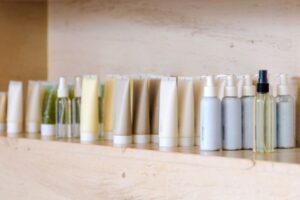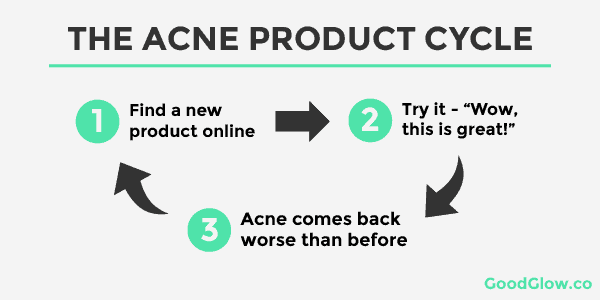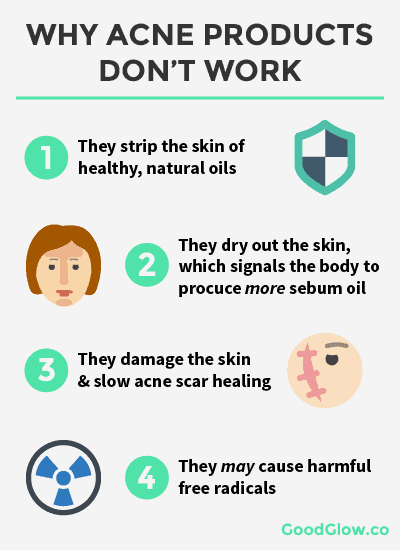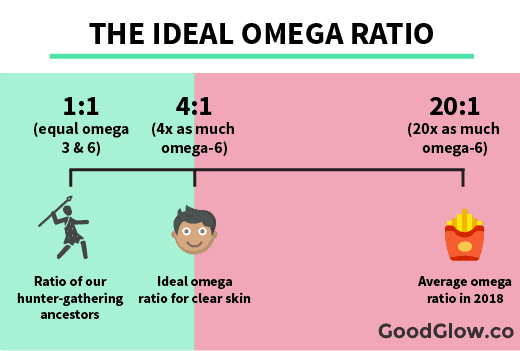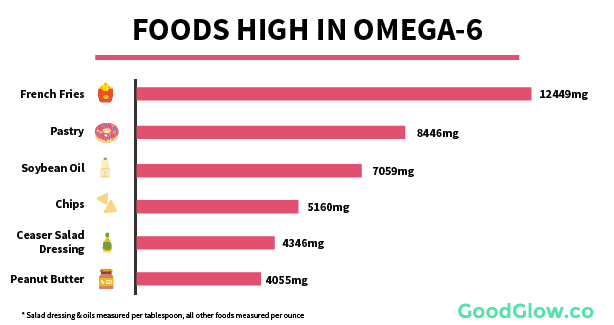How many different acne products have you tried?
More importantly, how much money do you think you’ve spent on cleansers, creams, and masks?
If you’re like me, you’ve tried just about everything. From harsh products containing benzoyl peroxide to “natural” treatments like aloe vera or tea tree oil, and everything in between. Dozens of different masks, routines, and moisturizers.
You’ve also probably spent hundreds, if not thousands of dollars over the years on different acne treatments.
Ask yourself this question:
Despite all this time, money, and stress, has your acne really improved?
If you answered “No”, you’re not alone. This is normal.
Go to any forum or online community about acne and you’ll see tens of thousands of people with the same problem – they’ve tried everything to get rid of acne, but it still won’t go away.
I found myself going through the same cycle over and over again with my acne:
- Discovery phase – Find a new skincare product and add it to my routine
- Honeymoon phase – “Wow, this thing actually works! This could be the product I’ve been waiting for!”
- Disappointment phase – One or two months later, my acne would come back worse than ever
This process is exhausting. It can leave you feeling stressed out and demoralized.
I had tried everything, and for months at a time:
- Benzoyl peroxide
- Salicylic acid
- Retin-A (for almost 2 years)
- Oral antibiotics
- Natural remedies like raw honey, tea tree oil, and aloe vera
- Organic plant-based soaps and lotions
And guess what – in the end, nothing really worked.
You’re left wondering why acne products can work for other people but they can’t work for you.
First of all it’s not your fault, and the reason is surprisingly simple.
Topical acne products don’t treat the root causes of acne, they only treat the symptoms.
After years of treating my acne with both over-the-counter and prescription medications, I was exhausted.
I wanted to treat the underlying causes of my acne, not just the symptoms. This led to me studying the link between diet and acne, trying out various experiments on myself, and this blog being born.
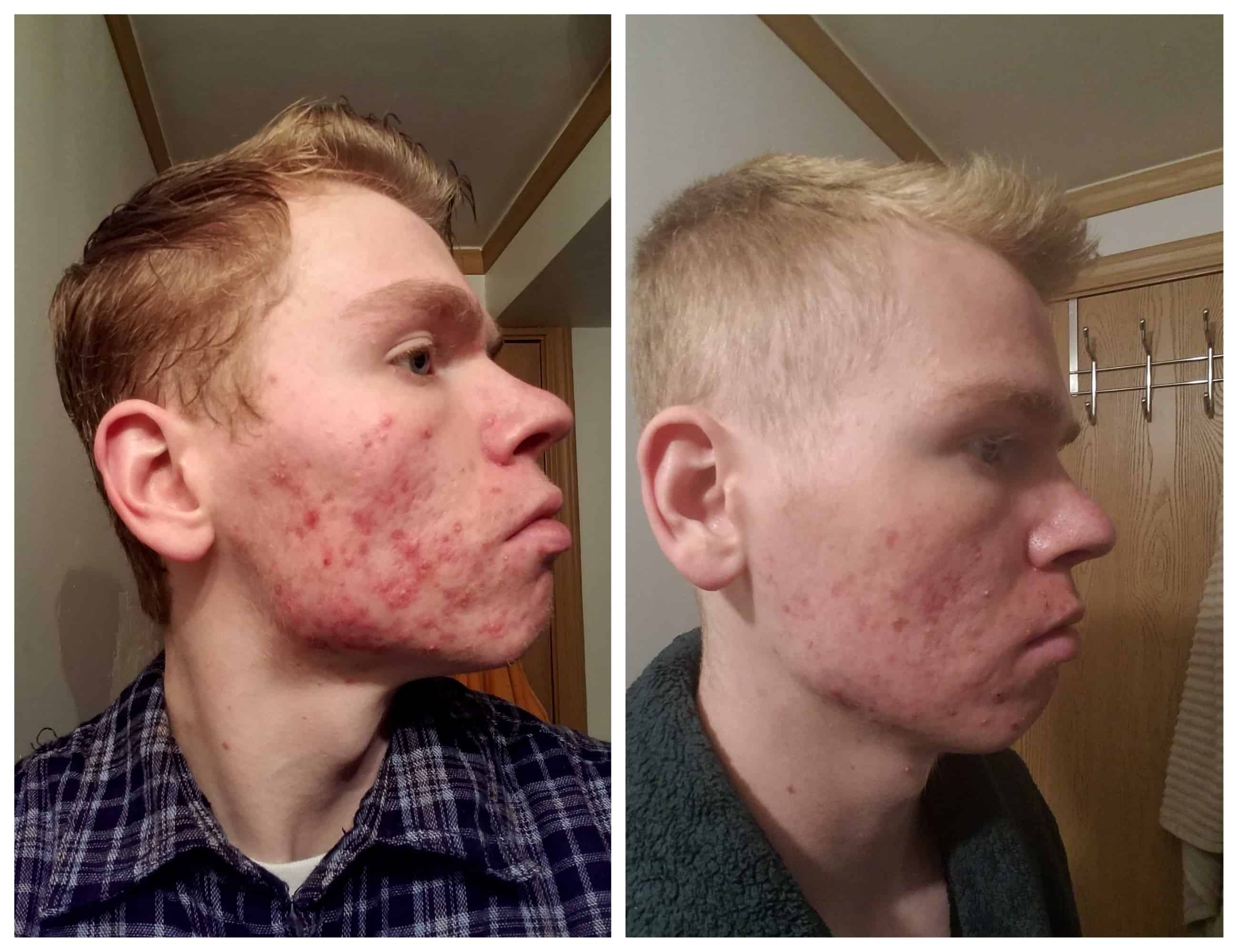
After hundreds of hours of research and years of experimentation, I finally feel confident that for many of us, the real answer to treating acne comes through your diet and lifestyle.
That’s the whole point of this article – to explain to you, using as much of the latest research as possible, why acne products don’t work, and why treating your acne internally may be a better path.
To do this, I’m going to break down a few things:
- The ongoing cycle of how acne forms on the skin
- Why acne products only address the symptoms of acne, not the root causes
- The real root causes of acne (including genetics, hormones, and diet)
- Why acne products “work” for other people but not for you
- Why treating your acne naturally is better
By the end of this guide, I want to give you the confidence and the tools you need to tackle your acne naturally.
The acne cycle – how acne forms
The surface-level process of acne has 4 key components:
- The body produces excess skin cells and sebum oil
- Dead skin cells and sebum oil clog the pore
- Acne bacteria swarm the clogged pore and infect it
- The body triggers an inflammatory response – creating a big, protruding, red pimple

Easy enough, right?
Well, the problem is, all of these issues work in conjunction with each other.
You can’t just wash away all your dead skin cells or sebum oil and expect to be acne-free. Your skin will adjust and adapt, and you’ll be left with worse skin than before. Unfortunately, that’s exactly how most acne products work…
How most acne products work – and why it doesn’t cure acne
The vast majority of over-the-counter acne products, including Proactiv™, Clean & Clear™, Murad™, Oxy™, Neutrogena™, and Stridex™, use benzoyl peroxide as the primary active ingredient in their cleansers, creams, and lotions.
Benzoyl peroxide is designed to dry out and flake off dead skin cells and kill acne bacteria before they can infect clogged pores.
It does this by using two primary mechanisms:
- Causing the skin to become dry and flake (thus removing dead skin cells)
- Killing acne bacteria on the surface of the skin
Simply put, benzoyl peroxide prevents pores from becoming blocked in the first place, and kills the bacteria that is creating acne.
It seems like this is a pretty bulletproof combination, right?
Wrong. Unfortunately, this is a short-term solution to a much deeper, long-term issue.
Why most acne products don’t work in the long-run
I’m just going to flat out say it – I recommend that no one uses acne products with benzoyl peroxide to treat their acne.
The reason for this is simple – while benzoyl peroxide does effectively eliminate acne in the short-term, the long-term risks of using benzoyl peroxide vastly outweigh the benefits.
Acne products eliminate good bacteria and oil on your skin
Just like your gut, your skin has a colony of good, healthy bacteria protecting it from infections, free radicals, and threats. Maintaining a healthy skin microbiome is crucial for long-term, healthy-looking skin.
Your skin also has a healthy layer of oil that protects it from outside threats, including acne.
Benzoyl peroxide is an antibiotic, which means it kills bacteria – while antibiotics are often better at eliminating a single strain or type of bacteria, they rarely only kill bad bacteria. Benzoyl peroxide can kill the good bacteria too.
Furthermore, benzoyl peroxide strips the skin of its natural protective oils, which leaves your skin dry and flakey. While this is good in the short term, the minute you stop using benzoyl peroxide, you leave your skin in a considerably worse place than where you began.
The bottom line is that benzoyl peroxide is damaging to the healthy microbiome of bacteria and oil on the skin, and can leave your skin less capable of healing acne on its own.
Ask yourself – Do you really want to be reliant on benzoyl peroxide the rest of your life?
Acne products lead to more sebum oil, not less
When you use acne products with benzoyl peroxide in them, it strips the skin of sebum oil.
While this might sound like a good thing, it’s really quite dangerous, and can cause more acne in the long run.
Sebum oil is naturally used to help moisturize and protect the skin – some sebum oil is necessary for healthy, acne-free skin.
The key is not having too much sebum oil, and preventing sebum oil from oxidizing (going bad or rancid) by eating a healthy diet (more on that later).
By drying out your skin and stripping it of sebum oil, your body actually overcompensates for the dryness the only way it knows how – by producing even more sebum oil. This leads to a vicious cycle of needing more and more acne products to keep your skin oil at bay.
This is a key reason why acne products might work for a few weeks, and then end up creating more acne over the long run.
Acne products damage the skin and make healing slower
Benzoyl peroxide doesn’t just strip the skin of natural oils – it strips it of essential vitamins and antioxidants it needs to fight off threats, including acne infections.
One study found that applying benzoyl peroxide to the skin resulted in a 50% drop of vitamin E within the first 30 minutes1https://www.ncbi.nlm.nih.gov/pubmed/11522381. Another found that it decreased levels of vitamin C on the skin by over 70%2https://www.ncbi.nlm.nih.gov/pmc/articles/PMC3012032/.
Vitamin E protects against free radicals and infections, while vitamin C helps protect against sun damage and scar healing3https://www.ncbi.nlm.nih.gov/pmc/articles/PMC5579659/.
The end result is damaged, dry, flaky skin, and acne scars that take longer to heal.
Acne products may generate dangerous free radicals
Free radicals are highly reactive, unstable little molecules that can damage your skin’s oils, proteins, and DNA4https://www.ncbi.nlm.nih.gov/pmc/articles/PMC3249911/.
Free radicals can form through a variety of ways – sometimes they’re created internally, while other times they’re created by outside factors like smoking, air pollution, eating trans fats, or, in this case, putting harmful chemicals on your face.
Without an antioxidant-rich diet, free radicals are much more likely to form, and they’re highly linked to acne and long-term skin damage5https://www.ncbi.nlm.nih.gov/pmc/articles/PMC4756869/. Several studies have even found a link between benzoyl peroxide and the formation of free radicals and tumors6https://www.ncbi.nlm.nih.gov/pubmed/8806712.
Have you ever wondered why smokers skin looks so aged and weak? Free radicals are to blame.
What does this mean for acne products? It means that not only can they cause more acne through free radicals, but they can also cause permanent, long-term damage to the skin.
Still, the case for benzoyl peroxide causing free radicals not conclusive – we simply don’t have enough evidence with our current studies to conclude the regular use of over-the-counter grade benzoyl peroxide can cause tumors and free radicals in humans.
With that being said, the European Union has already taken steps to make benzoyl peroxide less accessible to the public by making it a prescription-grade drug.
Putting it all together – why you can’t rely on acne products
Simply put, acne is created because of several factors:
- Too much skin oil
- Too many skin cells
- Skin cells that don’t shed properly
- Skin that can’t protect itself against free radicals
- Inflammation after an acne infection takes place
Acne products like Proactiv work by removing your skin’s natural oils and drying out the skin – but guess what? They don’t address what’s causing the core issues in the first place.
In addition to causing lasting damage to your skin, benzoyl peroxide won’t stop your body from producing the excess sebum oil that’s causing your acne in the first place. In fact, you’ll likely produce even more sebum oil to overcompensate for the dryness. It also is unlikely to stop the internal mechanisms that lead to too many skin cells being produced.
On top of that, it decreases your skins ability to protect itself against free radicals that damage and age the skin, which also slows how quickly your skin can heal.
Acne products with benzoyl peroxide are merely covering up the symptoms of acne, not treating the underlying biological mechanisms that create them.
This begs the question – what truly drives acne then?
What really causes acne – diet, hormones, genetics
As I outlined above, the acne cycle is driven by several components that work together to create acne.
But what makes the skin produce too much sebum oil in the first place? Why is our skin not properly shedding? Why is our immune system turning a harmless little infection into a massive pimple?
It all comes down to a few major biological factors:
- Dietary-driven hormones like insulin and IGF-1, caused by eating too many carbs, sugar, and dairy, tell the body to produce too many skin cells and too much sebum oil
- Chronic inflammation caused by eating too many unhealthy omega-6 fatty acids (found in fried and artificial foods) and not enough healthy omega-3 fatty acids
- A lack of antioxidants to protect against free radicals and skin infection
- Nutritional deficiencies in vitamin A, zinc, and omega-3 fatty acids
- Poor gut health caused by the overconsumption of grains and sugar also leads to inflammation and nutritional deficiencies
- Sex hormones (androgens) lead to excessive production of sebum oil
Together, these root causes are responsible for most of the underlying biological mechanisms that create acne. While I won’t go into great detail in this article how each of the factors affects acne, I will give you a basic picture for each, along with more resources to learn about each.
How carbs and sugar cause acne
Carbs and sugar trigger large amounts of a hormone called insulin to be released in the body.
Insulin isn’t usually a bad thing, but in very high amounts, it can trigger the sebaceous gland to produce to much skin oil and too many skin cells.
In addition, insulin triggers the release of three other acne-causing hormones:
- IGF-1 – Increases sebum oil production, overproduction of skin cells, promotes inflammation (this one is especially bad for acne)
- IGFBP-3 – Prevents skin cells from shedding properly
- IL-1 – promotes inflammation (turns acne infections into pimples)
Unfortunately, the ADA estimates that half of all US adults have some form of insulin resistance7https://www.healthline.com/health/diabetes/insulin-resistance-symptoms, which just means that every time you eat carbs, your body releases a ton of insulin to convert those carbs into energy.
This leads to an insane amount of acne-causing hormones.
One study found that a diet lower in high glycemic index carbs (foods like french fries, pasta, or bread, that trigger lots of insulin) resulted in significantly less acne after just 12 weeks. 8https://watermark.silverchair.com/znu00707000107.pdf?token=AQECAHi208BE49Ooan9kkhW_Ercy7Dm3ZL_9Cf3qfKAc485ysgAAAkgwggJEBgkqhkiG9w0BBwagggI1MIICMQIBADCCAioGCSqGSIb3DQEHATAeBglghkgBZQMEAS4wEQQMHGaPAlzc0o18i86WAgEQgIIB-xruJLMjoA27ddifmBrVUKigOY_5Wny506-4ADlw8xG8A5RYJbt3H6aNGnou6aO-dYlM1qXhWic-LSO6Ornxbp4n24XE4hlrVeSGYz9PtKH_g5XicL7FBLkTYfc2HDfl4hbb9mQWgKBjOwg9mFqlnz_H3UUQWJCVfnxPaSCgxZwfYdZnH5lsuJOJWyqbSzxT4HZ-pPncyjQeTkO35t2ZDf0-3pqn1d7adqJ4LYk5Zuq2EeKBH_7TqVmGxR42cT_IAINuAEAZwTjbldnueRLebEGTg69Is_u7u4TkE6hUXxLRFQGUYU8O5Tq1851AiEv7AppqLm0TbSTkuMB0IOjJSgR2d7142_wEBzfg2zCXQf6ts7AX7gV8_noG1CyQumwUvcOTp-40teqLDbOf96plWYDFtLPpn9TUujLRsGgnFMqhWNu2TUOcytekH2L3vpTg5nXXeWzg8150753WrZwIvlYuIlR3XWeesq2DCKgRjrKNBix49YLvrk9xNTFATVGAqPnaoCmCoD4v8aqoxKvcP2AFul-stA2mEMyvxFcxwWwST-NqUdNoLoxmCSn3BpMvSMF4NeqyvGnQxq2EEFDyNBluNMYRsi_oIuk0ZtYlFQtiazJyyYQci4hAa4zIKcNkQ4AVq-2fiphgER6bJgQlL9WY02fs1LldarcSbA The study wasn’t even testing whether or not a low-carb diet (like keto) could get rid of acne, they were just seeing if cutting out the worst offenders made a dent, and it certainly did.
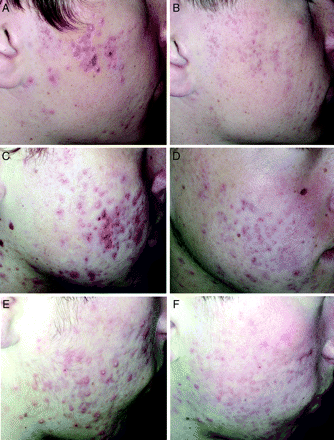
You can read my full guide on carbs, sugar, insulin, and acne here for more information.
How dairy causes acne
Most diary can be extremely problematic for acne for a few reasons:
- Dairy contains hormones (insulin, IGF-1) that tell the body to overproduce skin cells and sebum oil
- Intolerances/sensitivities to whey, casein, and lactose (proteins and carbs found in dairy) is extremely common
- Casein can damage the gut and lead to leaky gut syndrome
- Most dairy triggers an extremely large insulin response – remember, insulin is a massive acne-causing hormone
- Dairy prevents essential skin-clearing nutrients, like zinc, from being properly absorbed
There are a few exceptions to the rule, but in general, dairy is one of the worst foods you could eat for acne.
INSERT STUDIES HERE
You can read my full guide to dairy and acne here
How chronic inflammation triggers acne
Inflammation is your body’s healthy, natural response to threats, like cuts or infections. We need inflammation to survive and recover.
Chronic inflammation is a condition where your immune system is on high alert and constantly firing off an inflammatory response to minor, non-important threats. One of these threats is acne infections.
Acne infections aren’t all that harmful by themselves and will go away without intervention. But when you suffer from chronic inflammation, the immune system sees this tiny little infection and thinks it’s a major threat. An inflammatory response is triggered, and the typical redness, swelling, and protrusion create a pimple.
Why does chronic inflammation happen? There are two main reasons…
How unhealthy fats cause acne
There are two main fatty acids that are responsible for the regulation of your body’s inflammatory response:
- Omega-6 fatty acids – inflammatory, generally bad for acne
- Omega-3 fatty acids – anti-inflammatory, generally good for acne
If you have too many omega-6 fatty acids and not enough omega-3 fatty acids, your immune system will be extremely sensitive to events like acne. You need to have a solid ratio of omega-3 fatty acids to omega-6 fatty acids.
Unfortunately, most Americans eat 20 times the amount of omega-6 fatty acids to omega-3 fatty acids9https://www.ncbi.nlm.nih.gov/pmc/articles/PMC4808858/.
What foods are highest in omega-6 fatty acids? Fried foods, artificial foods, and vegetable oils.
What foods are high in usable omega-3 fatty acids? Fish, and pretty much only fish.
You can read my full guide to chronic inflammation and acne here
So, what’s the other factor that can cause chronic inflammation?
INSERT LINKS TO STUDIES ON INFLAMMATION WITH O6 VS. O3 AND INFLAMMATION WITH REGARDS TO ACNE
How poor gut health leads to acne
The other primary driver of chronic inflammation (an overactive immune system) is various gut disorders, primarily leaky gut syndrome.
Leaky gut syndrome is exactly what it sounds like – it’s a condition where the membrane or wall of the intestine has a hole in it, and proteins can pass through it, into the bloodstream.
When this protein enters the bloodstream, the body obviously sees it as a threat, and thus fires off an inflammatory response. Needless to say, if your body is attacking itself everytime you eat certain foods, you’re going to have a pretty messed up immune system.
What foods cause leaky gut syndrome? Foods with lectins.
Lectins are proteins that plants use to protect themselves against the threat of being eaten. Just like animals, plants don’t want to be eaten and will go to great lengths to damage the digestive system of the animals that eat them.
Not all people are sensitive to all lectins, but overconsumption of grains (including non-white rice, quinoa, beans, legumes, oatmeal, etc.) can lead to digestive issues linked to acne.
For more information on leaky gut syndrome, I recommend reading this article
How Nutritional Deficiencies Cause Acne
There are various nutrients that are essential for clear skin.
Unfortunately, most of us with acne are deficient in these nutrients:
- Zinc is aids the immune system, acts as an antioxidant to protect the skin, regulates apoptosis (dying and shedding of old skin cells), improves sleep, and decreases stress. One study found that 30mg of zinc per day led to a 50% decrease in acne after 3 months10https://www.karger.com/Article/Abstract/51728. In addition, one study found that 54% of participants with acne were deficient in zinc, while only 10% of the non-acne group were zinc-deficient.
- Vitamin D is a hormone that helps prevent chronic inflammation, influences genes that trigger skin cells, and influences the absorption of other nutrients. One study found that roughly 95% of people who suffer from acne are also deficient in vitamin D11https://www.ncbi.nlm.nih.gov/pubmed/26413187.
- Vitamin A reduces the size of the gland that produces sebum oil, improves wound healing, regulates the skin shedding process, reduces inflammation, and acts as an antioxidant to protect the skin. Vitamin A levels on the skin of acne patients have been shown to be lower than non-acne patients12https://www.ncbi.nlm.nih.gov/pubmed/2933053.
These are just a few examples of common nutritional deficiencies that lead to acne, but they get the point across well.
Even if you’re eating tons of vegetables or fruit, you might not be getting all the nutrients you need.
For instance, upwards of 97% of all vitamin A found in plants fails to be converted into usable vitamin A13https://www.ncbi.nlm.nih.gov/pmc/articles/PMC2854912/. The ALA omega-3 fatty acids found in nuts and seeds is extremely inefficient for the body to convert into DHA & EPA omega-3.
What about genetics and hormones?
Genetics and hormones do play a huge role in acne, there’s no doubt about that – but despite unlucky genetics, you can still achieve clear skin.
We all know that one friend who can eat whatever they want and not break out or even gain any weight.
Genetic factors may be at play here.
Some people are simply not prone to acne due to naturally small sebaceous glands, better functioning digestive systems, a healthier skin microbiome, decreased insulin sensitivity, a healthier gut microbiome from avoiding antibiotics, you name it.
Other people (especially those going through puberty) have a tough time beating acne due to a massive inflow of male sex hormones known as androgens.
Androgens are present in both men and women and are a primary driver behind how much sebum oil the sebaceous gland releases. That’s one reason why you’re likely to have a lot more acne as a teenager than an adult – your body is flooded with androgens and producing oil like crazy.
Still, even if you are prone to acne genetically, that’s not to say you can’t minimize acne by stopping it at the source.
Genetics may make you more prone to acne, but they don’t make you destined to suffer from it.
Sure, some lucky folks may not have to be as careful as you are with the carbs or gluten, but it’s not a dealbreaker, and as you’ll see in a little bit, it can actually be a gift in disguise.
What about other acne treatments?
While you’ll find that most acne treatments use benzoyl peroxide, you may find some over-the-counter and prescription alternatives.
While I won’t go into massive depth in this article about all these alternatives, I will address a few of the most common ones.
Salicylic Acid
Salicylic acid is another popular ingredient in over-the-counter acne cleansers and creams.
Salicylic acid comes from willow tree bark, and due to its acidic properties, it unclogs pores and loosens old, dead, dry skin. This process can prevent pores from becoming blocked and acne infections taking place.
The downsides of salicylic acid are redness, irritation, and dry skin. Furthermore, salicylic acid does not treat the underlying causes of acne.
From personal experience, I’ve seen salicylic acid work for months, only to stop when the skin becomes adapted to it. I’m left with damaged, red, and dry skin.
While I personally believe that the skin microbiome fares better without salicylic acid, it is a much better choice than benzoyl peroxide and may be useful for minor cases of acne that don’t require dietary intervention.
Oral Antibiotics
Please, please, please – don’t take oral antibiotics to treat your acne.
We all know that good gut health is key for great looking skin. Your gut flora, or the balance of bacteria in your gut, is a huge factor in whether or not you’ll digest food properly, absorb nutrients, and have a properly functioning immune system.
Many dermatologists believe that by using antibiotics that aim to destroy certain strains of bacteria in the gut, you can remove the acne-causing bacteria and be left with a good-ole’ happy digestive system.
This is simply incorrect.
A single dosage of oral antibiotics can permanently damage your gut microbiome.
While you may experience benefits at first, the long-term damage caused by taking an oral antibiotic for acne, like tetracycline, minocycline or doxycycline, is almost certainly going to cause you more acne in the future.
While I have no scientific evidence to support this, I strongly believe that a large part of my adult acne was caused by excessive antibiotic usage during my childhood and teens. Thanks, dermatologists!
Retin-A/Tretinoin
Retinoids are topical forms of vitamin A that helps with the shedding of dead skin cells. They exfoliate the skin and help fight against inflammation.
I think retinoids are a much safer alternative to benzoyl peroxide, but still, it’s not without downsides:
- Irritation
- Swelling
- Redness
- Peeling
- Extreme sensitivity to sun exposure
Trust me, after nearly 2 years of using a low-concentration of tretinoin and still having red, inflamed, peeling skin, it’s hard to say it’s the cure-all.
Topical retinoids may also affect your skin’s ability to utilize vitamin A on its own.
Accutane
Just like antibiotics, I just simply wouldn’t recommend Accutane, as the risks vastly outweigh the benefits.
Accutane functions by reducing the size of the glands that produce sebum oil. It is a powerful drug that affects several major aspects of the body, not just the skin.
While this process leads to less oily, acne-prone skin, it also means your skin will be extremely dry, red, and inflamed. Without natural oils to protect the skin, extreme sensitivity to the sun and other external stimuli is common.
While Accutane may be a powerful method for treating severe cases of acne, the potential side effects are just equally as potent:
- Hair loss
- Heart disease
- Dry mouth
- Intracranial hypertension (increased pressure around the brain)
- Birth defects
- Depression
- Mood and energy swings
While these side effects are not extremely common, they do occur, and it’s worth asking yourself if getting rid of acne is worth risking your long-term health.
I know how bad acne can suck, but ask yourself if it’s really worth losing your hair, damaging your digestive system, or altering your mood in order to get rid of it, especially when health and lifestyle changes can result in drastic transformations in skin health without the side effects.
Why acne products “work” for other people but not for you
If you buy skincare products off of online, you probably see tons of products with 4 or 5-star reviews.
So, you order it, try it out for 2 months, and go through the honeymoon phase, only to find that your acne comes back worse than ever.
You think to yourself, “how could all those other people get rid of their acne with this product but I can’t?”
This is normal.
Despite what you might see on TV commercials with before and after photos and online reviews of skincare products, most acne cleansers, creams, and masks don’t work for most people.
Even though it might seem like everyone is getting great results with them, there are just as many people who don’t experience positive results.
So why do people rave about these products? Why do they all have 5-star reviews?
#1. Skincare companies incentivize customers to leave reviews
Health and beauty companies, including acne products and supplements, will give incentives and rewards to review their product online.
If I told you that you could get another month of your skincare routine paid for, and all you had to do was leave a little review, would you do it? Heck yeah!
While they don’t necessarily say whether or not to leave a negative or positive review, the implication is clear – “you scratch my back, I’ll scratch yours.”
#2. People leave reviews in the “honeymoon” phase
With some products, your acne gets worse before it gets better.
Others might clear up your skin considerably in a very short period of time. It finally feels like you’ve found the one acne product that’ll solve all of your worries. No more stressing out about your skin, no more searching for the perfect product.
I call this the “honeymoon” phase.
What follows the honeymoon phase is the disappointment phase, when a month or two later your acne comes back worse than before.
A lot of people will leave positive reviews for an acne product during the honeymoon phase, only to throw the product in the trash a month later.
#3. People with a bad experience are less likely to leave a review
If you use Yelp or TripAdvisor a lot and have a horrible experience with a restaurant, you’re probably pretty likely to leave a bad review, right?
The opposite is true of skincare products.
Why?
Because when you struggle with acne and try this brand-new, innovate, 5-star product and it doesn’t work, what’s your first thought?
It’s that something is wrong with you.
How could it work for everyone else and have 5-stars online if it didn’t work?
You start to rationalize the product not working, by saying things like:
- “This product just doesn’t work for my skin type”
- “I didn’t try it long enough”
- “It must be one of the other products I’m using that makes me break out”
You don’t run to the internet and write a negative review. Instead, you start looking for the next best acne product to “cure” your acne.
In summary, you’re not weird or unique because acne products that have 5-stars online or amazing before-and-after images don’t work for you. While they might work for some people (for a while, at least), they certainly don’t work for everyone.
Why you treating your acne naturally is better
Even if you can cure your acne with over-the-counter cleansers, prescription antibiotics, or meditations, there are a few reasons you might not want to.
1. Acne is a sign of underlying health issues
By now you probably understand that acne is only a symptom of greater health issues.
Acne can be caused by several serious health issues:
- Insulin resistance caused by eating too many carbs
- Chronic inflammation caused by eating unhealthy fats and oils found in artificial foods
- A damaged digestive system caused by eating too many grains, antibiotic usage, or chronic stress
These aren’t just surface-level ailments that’ll go away with time – these are serious health issues that could really have a negative effect on your life in the long-run.
Your body is trying to tell you something – don’t you think it’s time you listened?
2. Stop stressing about your skincare routine (and save money)
When I was still trying to cure my acne by using cleansers and creams, I tried just about every combination of skincare products imaginable.
I went through phases, first tackling my acne with powerful and harsh over-the-counter benzoyl peroxide and salicylic acid.
When that didn’t work, I went to a dermatologist and was prescribed oral antibiotics, tretinoin, and even more benzoyl peroxide.
Later, after my skin was completely ruined and my acne worse, I tried more natural products, like honey cleansers, tea tree masks, and soothing lotions.
By the end of all of this, I still felt like I was playing whack-a-mole with my acne. I was constantly on the lookout for breakouts, but could never stop them from happening in the first place. Not to mention I had spent hundreds, if not thousands of dollars on my skincare routine over the years.
That all changed when I started treating acne from the inside with my diet and lifestyle.
Ask yourself a few questions:
- Wouldn’t it be nice to stop stressing out about whether or not your skincare routine is perfect?
- Wouldn’t it feel great to know that because you live a healthy lifestyle, you don’t need to have the perfect skincare routine to have amazing skin?
- How much more money you would save if you didn’t have to constantly buy new acne products that only seem to make things worse?
By treating your skin naturally, you free up not only a lot of time and energy but also a lot of money too.
You can go to bed at night knowing that your lifestyle has your back.
3. Be healthier, feel better
I know this is going to sound crazy, but having acne can actually be a gift in disguise.
Before I started looking at my diet and lifestyle for acne, I was in horrible shape.
I rarely worked out, I ate crazy amounts of junk food (tortilla chips, chicken tenders, fries, and pizza were my go-to’s), and was always stressed out.
It’s really no wonder that my skin wasn’t healthy!
When I started to clean up my diet, exercise more frequently, and focus on my mental health, my whole life started to change.
Sure, my acne began to clear up pretty quickly, but still, after years, it’s not perfect, and it may never be.
But you know what?
I feel so much better than I did before.
I have more energy, more mental clarity, and less stress each and every day. I feel like a different person compared to who I was a year ago, and I really, truly attribute that to my diet and lifestyle. You’d be amazed how much better you can feel on a daily basis by being conscious what you put into your body. Even if my skin didn’t clear up, I’d still continue to eat and live the way I do because it makes my life that much better.
How to get started treating acne naturally
The first step I’d recommend anyone take has nothing to do with your diet or your lifestyle, but rather your mindset.
You need to fully commit to healing your skin from the inside.
It’s not an easy journey.
You may have to cut out foods that you’ve been enjoying for years. You’re going to have to change eating habits and embrace new habits that encourage a healthy lifestyle.
Changes aren’t going to happen overnight, and you’re going to need to overcome obstacles along the way.
But at the end of it, not only will your skin clear up, but you’ll be healthier, you’ll feel better, you’ll have more confidence and energy.
I can’t guarantee that your life will change by tackling acne from the inside-out, but I will tell you that my life certainly did.
I know what you’re probably thinking – “great, okay we get it, more energy, life-changing, blah blah blah… Where can I really get started?”
The GoodGlow.co Diet Blueprint is the single best place to get started when it comes to a diet engineered for clear skin.
It’s based on three key principles:
- Avoiding foods that trigger excessive insulin
- Avoiding foods that trigger inflammation
- Avoiding foods that cause gut damage
For most people, it’s everything you need to get started. Everyone is different and brings their own unique quirks to the table. While some people might tolerate potatoes just fine, it might cause other people to break out like crazy.
If you’re looking for more in-depth information, I have a few resources I think might come in handy:
